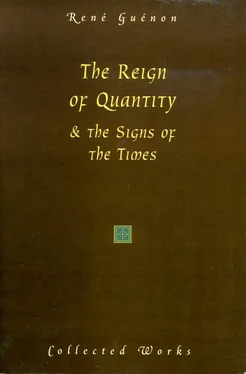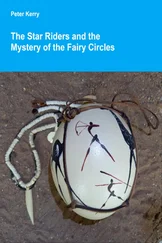In the first place, yet one more confusion and error of interpretation arising from the modern mentality must be dissipated, and that is the idea that there exist things that are purely ‘material’. This conception belongs exclusively to the modern mentality, and when it is disencumbered from all the secondary complications added to it by the special theories of the physicists, it amounts to no more than the idea that there exist beings and things that are solely corporeal, and that their existence and their constitution involve no element that is not corporeal. This idea is directly linked to the profane point of view as expressed, perhaps in its most complete form, in the sciences of today, for these sciences are characterized by the absence of any attachment to principles of a superior order, and thus the things taken as the objects of their study must themselves be thought of as being without any such attachment (whereby the ‘residual’ character of the said sciences is once again made evident); this kind of outlook can be regarded as indispensable in order to enable science to deal with its object, for if a contrary admission were made, science would at once be compelled to recognize that the real nature of its object eludes it. It may perhaps be superfluous to seek elsewhere the reason for the enthusiasm displayed by scientists in discrediting any other conception, by presenting it as a ‘superstition’ arising in the imagination of ‘primitive’ peoples, who, it is suggested, can have been nothing but savages or men of an infantile mentality, as the ‘evolutionist’ theories make them out to have been; but whether the reason be mere incomprehension on their part or a conscious partisanship, the scientists do succeed in producing a caricature of the situation convincing enough to induce a complete acceptance of their interpretation in everyone who believes implicitly in whatever they say, namely, in a large majority of our contemporaries. This is what has happened in the particular case of the ethnologists’ theories about what they have agreed to call ‘animism’; strictly speaking this word might well possess an unobjectionable meaning, but only on condition that it were understood quite otherwise than they understand it, and that no meaning which is not justifiable etymologically were admitted.
The truth is that the corporeal world cannot be regarded as being a whole sufficient to itself, nor as being isolated from the totality of universal manifestation: on the contrary, whatever the present state of things may look like as a result of ‘solidification’, the corporeal world proceeds entirely from the subtle order, in which it can be said to have its immediate principle, and through that order as intermediary it is attached successively to formless manifestation and finally to the non-manifested. If that were not so, its existence could be nothing but a pure illusion, a sort of phantasmagoria behind which there would be nothing at all, which amounts to saying that it would not really exist in any way. That being the case, there cannot be anything in the corporeal world such that its existence does not depend directly on elements belonging to the subtle order, and beyond them, on some principle that can be called ‘spiritual’, for without the latter no manifestation of any kind is possible, on any level whatsoever. Confining attention to the subtle elements, which must therefore be present in everything and are merely more or less hidden according to circumstances, it can be said that they correspond to that which properly speaking constitutes the ‘psychic’ order in the human being; it is therefore legitimate in every case, by a natural extension implying no ‘anthropomorphism’ but only a perfectly valid analogy, also to call them ‘psychic’ (and that is why a cosmic psychism was spoken of previously), or even ‘animic’, for these two words, according to their original meanings and their respectively Greek and Latin derivations, are really precisely synonymous. It follows from this that there can in fact be no ‘inanimate’ objects in existence, and also that ‘life’ is one of the conditions to which all corporeal existence without exception is subject; and that is why nobody has ever arrived at a satisfactory definition of the difference between the ‘living’ and the ‘non-living’, for that question, like so many others in modern philosophy and science, is only insoluble because there is no good reason for posing it, since the ‘non-living’ has no place in the domain to which the question is related, and the only differences involved are really no more than mere differences of degree.
Such a way of looking at things can be called ‘animism’ without objection, if that word is held to imply nothing more or other than the affirmation that there are ‘animic’ elements in all things; it is clear that this kind of animism is directly opposed to mechanism, just as reality itself is opposed to mere outward appearance. It is equally clear that this conception is ‘primitive’, but it is so quite simply because it is true, which is almost exactly the opposite of what the evolutionists mean when they qualify it in that way. At the same time, and for the same reasons, this conception is necessarily common to all the traditional doctrines; it can therefore be said to be ‘normal’, whereas the opposite idea, that of ‘inanimate’ things (of which one of the most extreme expressions is found in the Cartesian theory of ‘animal-machines’) represents a real anomaly, but then so do all specifically modern and profane ideas. But it must be clearly understood that the traditional conception in no way implies any ‘personification’ of the natural forces that are studied by the physicists after their own fashion, and still less any ‘adoration’ of those forces, as is made out to be the case by those for whom ‘animism’ is something they think they can call ‘primitive religion’; in actual fact the only considerations involved are such as belong exclusively to the domain of cosmology, and they can find their applications in various traditional sciences. It should be superfluous to point out that the question of the ‘psychic’ elements inherent in things, or of forces of that order expressed or manifested through things, has nothing whatever to do with the ‘spiritual’; the confusion of these two domains is yet another purely modern phenomenon, and is doubtless not unconnected with the idea of making a ‘religion’ out of what is really science in the most precise sense of the word; our contemporaries, despite their pretensions to ‘clear ideas’ (evidently a direct inheritance from the mechanism and ‘universal materialism’ of Descartes) mix up in a very curious way the most heterogeneous things and those that are the most essentially distinct!
It is important to note at this point, in view of what is to follow, that the ethnologists habitually treat as ‘primitive’ forms that are only degenerate to a greater or less extent; and these forms are in any case very often not really on as low a level as might be supposed from the accounts that are given of them; however that may be, this explains how ‘animism’, which is in itself only a particular feature of a doctrine, has come to be taken as characterizing a doctrine in its entirety. Indeed, where there is degeneration, it is naturally the superior part of the doctrine, its metaphysical or spiritual side, that disappears more or less completely, so that something that was originally only secondary, and in particular the cosmological and ‘psychic’ side — to which ‘animism’ and its applications properly belong — inevitably assumes a preponderant importance. The remainder, even if it still persists to some extent, may easily elude the observer from outside, all the more so because that observer, being ignorant of the profound significance of rites and symbols, is unable to recognize in them any elements belonging to a superior order (any more than he can recognize them in the vestiges of completely extinct civilizations) and thinks that everything can be explained indifferently in terms of magic, or even sometimes of mere ‘sorcery’.
Читать дальше











